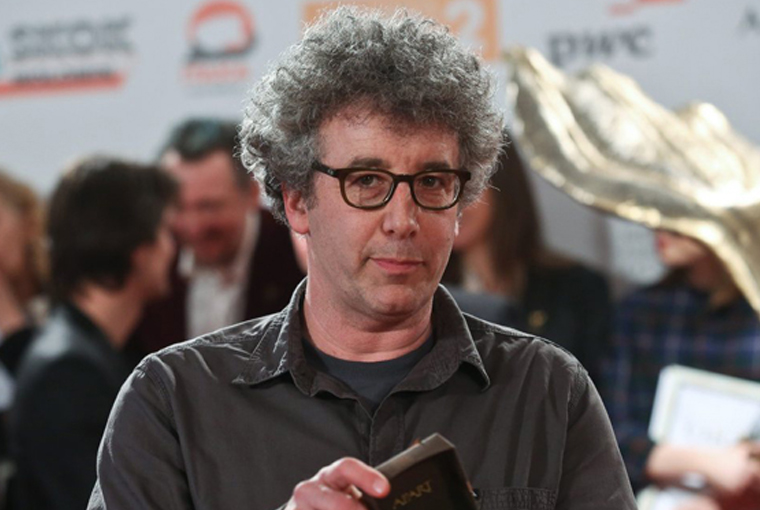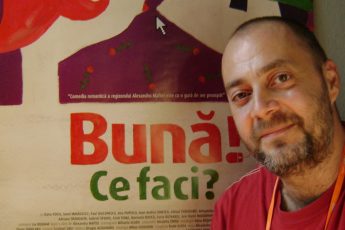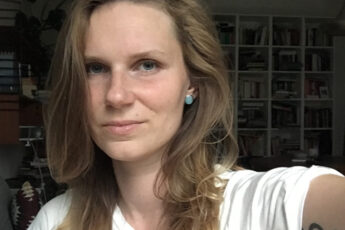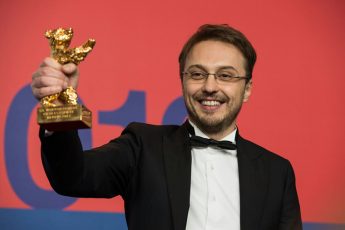
Pawel Łoziński is the son of famous Polish documentary maker Marcel Łoziński, but in recent years has carved out a reputation as a significant documentarian in his own right, and one who is unafraid of pushing that particular film form to its very limits. His films are marked by a careful, observational approach, and tend to focus upon highly emotive aspects of their protagonist’s lives. This interview was carried out after Łoziński had introduced the German Premiere of “You Have No Idea How Much I Love You” (2016) at goEast 2017, Wiesbaden.
[Note: the interview reveals crucial details about the film that will change a viewer’s experience of it.]
Basically, what I first of all want to talk about is a few of the background details about the film production. What was the first germ of an idea you had for the production? And how did you then go about putting the production into motion?
So, at first I wanted to make a film about mediation during a divorce. And in the beginning I had a lot of chances to pursue this because my friend had just started to work as a mediator. He took around eighty hours of lessons, as this is obligatory in Poland.
To get a license, yes?
Yes, you have to do eighty hours of training to get a license. He is a French guy by the way. He did the training and then he started to be a mediator. Then one day he called me and told me that his work is a good subject for a film, looking at couples during a divorce. But how do you arrange such a film, how can you make people in that situation talk freely in the presence of the camera? But then my friend told me it will be okay, I will get back to you shortly with some protagonists. And he did. After three weeks he called me and said there is one couple, and they have agreed to be in a filmed documentary. So myself and my cameraman took a camera and shot three or four scenes of this couple during a mediation session. Just to clarify, mediation is for when a couple is at war, there are high emotions and some specialists try to help them to ease the separation, usually for the sake of their children, for example. This is the main reason I think. So, after I had filmed this couple I realized that what I had was more like documentation, or research, for a film. Using this material I wrote a script and I tried to collect some money together to start the film. With the help of a media program I was able to get some more money to carry out further research.
Okay, and at which point did the Polish Film Institute come on board?
They are always giving money at the end stage of production.
So getting back to your initial idea for the film, how did that morph into what we actually see in “You Have No Idea How Much I Love You”? You’ve started with a husband and wife in mediation, but you’ve ended up with a mother or daughter in therapy.
Well I’d had many problems to convince my original protagonists to be in the film. We even waited a period of time to try and get them on board, which I have never done before. After that we were waiting in the mediator’s room with cameras and lights.
But then you ended up with this mother-daughter situation?
No, it ended up with me meeting a friend of my family, and she’s a psychotherapist, and she’s working in Denmark. She was on holidays in Warsaw, and we met completely by chance, as I hadn’t seen her since I was very, very young. So we met up for dinner and she asked why I was so sad. At that point I told her about the film and why I was unable to make it. She asked me what the film was about and after I told her. Then she asked me whether I had considered making a film about psychotherapy, as it would surely be much better. I told her that it was a great idea, but how do we make a film about psychotherapy, if those sessions are so private and so confidential. Then she told me that she has an idea how we could deal with this.
And what was that idea? Tackling it with those actors working through their own experiences?
Ah, now this is a problem. In all interviews I refuse to talk about my method because it should be known after someone has seen the film and not put out there from the beginning. So maybe you will just take it that I have a certain method and then talk about other things.
Right, but may I ask about one of the practical things. One of the things that struck me in the film, in terms of the way you edit, was that you have a formally rigorous approach. The camera frame remains fixed tightly upon the face in each shot, with very little movement.
Nothing, almost nothing.
There was one other shot though that stood out as a result of this formal rigour, namely a panning motion between mother and daughter. I am just wanting to know a little bit about what was your intention with this shot?
Well these shots are panoramas. We used these panoramas on purpose, because I wanted the viewer when they are watching the film to not feel cheated. When there is a cut, the viewer could feel cheated, but when there is a panorama the viewer reads that moment as being true. So that is why I use it, as I want those moments to feel very natural and true.
I also would like to talk about the actors that you have chosen…
You cannot put it like this. The ladies you have chosen.
So what was your casting process that helped you to select these women for the film?
I cannot answer this question… this is procedural.
You also use the length of shot in an interesting way, so that the edits don’t necessarily happen on a line of dialog, but instead the shot is held even when someone else within the shot, maybe someone we cannot see properly, is talking. What made you go with this more enigmatic approach to focusing attention within the scene?
Dramaturgy. Sometimes we need a lot of silence in a ‘talking heads’ film. Sometimes we need to cut something in the middle and just stop it. There were five sessions and the order was generally chronological. The actual sessions ran in the order they appear in the film, which means that we didn’t change the pace of dialog. It was very rare anyway, because those sessions were made so brilliantly, already, by de Barbaro. The structure and dramaturgy were already established by him within the scenes, which made the film very easy to cut. All we needed to do was cut slightly and compress. All the sessions were shot in order first to fifth.
This is a very interesting aspect of the film that you are confirming to me here. In essence you have the dramaturge actually in situ within the film, in the form of de Barbaro, the psychotherapist. Now there are elements within the film that show him establishing a kind of protocol, the way that the people are to interact, and he channels them down certain routes.
Yes, but I simply took the chance to use what he was giving me. Everything from protocol to strategy, not a script, but a strategy. He has thirty years of experience, so you know.
What was the form of psychotherapy that he was using?
System therapy, psychodynamics. I think psychodynamics. But he is always saying that he is just using the type of psychotherapy best suited to this particular, special patient. He is very open to different methods.
In terms of the two actresses then, who, of course, aren’t actually actresses.
Protagonists. You need to use this word.
So you had an array of people playing out these roles and you selected these two?
But you cannot say they play these roles, they are simply being a family. So, I’m sorry.
No, you see this is the thing. Genuinely, the first time I watched the film I was aware that you couldn’t possibly be filming someone’s therapy session. At the back of my head, I was asking myself how can he be doing this? But it was so, plausible and authentic.
So this was a good message for you.
Can I ask you what kind of decisions you made in terms of costume design.
Costume? It’s a documentary. Come on. No make-up, no costume, nothing.
Ok, I understand that, but what I’m hinting at here…
…this is a 100% cotton documentary, you know.
Yes, but what I am hinting at here is it looked to me as if there was some patterning in terms of the clothing that they were wearing.
But, it’s their choice. It is their choice.
Okay that is fine. But am I wrong to think there was some kind of schema, not in terms of fashion or design, but in terms of color, plain and simple.
In session number five Hania even came with a white shirt, which was completely forbidden for the film.
I noticed that.
But still she came like this.
Yes, well it is things like that which I am reading into, because you have, in that final session, Hania in a white shirt and the mother wearing a white jumper. At a certain point you have one of them wearing grey and another black, and then in another session this is reversed.
Maybe there is something there, but that was their choice.
Right, this was what I was trying to get at, because for me what I am interested in, I know you are making a documentary…
Of course, you are very suspicious, but you are right. Okay, let’s talk about emotions. Okay.
I’m just curious about the structure of the film. When you were actually then shooting each of the separate sequences were you letting the scene run in real-time with the three camera set-up?
Yes.
And then you’re taking from those three cameras the edits.
Yes, so each session was like fifty minutes.
So you were running out this duration on camera, then editing? So are you going into this completely raw, or do the protagonists have a dry run at it?
No, they were like mother and daughter and that’s it.
Okay, I think the other thing I really loved in the film was the time you give to reaction shots, so you in fact give over so much in the film to the scrutiny, the attentiveness of another person. Whether that be the therapist, giving his very piercing stare, but at the same time there is something kind of reassuring about it…
Yes, but it is also authentic and with empathy.
You had these reaction shots, and you are giving time over to them, and the thing I was really enjoying about these was the stillness you bring to them. Allowing the actor the room to focus…
Protagonist. I should change the inscription at the end to ‘they are not actors’.
There we go.
But if someone wants them to be actors, they will be actors for him. If someone has a problem with this inscription that this is not true, then they are actors for them.
I don’t even have a problem with that, it’s just that you naturally want to discuss this as a performance.
I have had a lot of discussions about this.
Can I ask then – as this would probably be quite a private thing on the set – but how difficult was it then to deal with the fallouts of pain, these strong emotions that are inevitably going to happen, particularly in the case of Ewa, the mother? How are you managing this on set.
I was behind the camera. I was not the director of sessions. The director of sessions is Mr de Barbaro. He is the one that asks Ewa to stop, to stop crying her sea of tears. This was his job.
Did you have a clear sense, once you had completed the shoot, that you were going to have these five segments? Or was that something that gradually emerged from out of the edit?
The Professor decided that the fifth session would be the last, even if as he said at the beginning… ah, but we cut that out. Well, originally he had proposed ten sessions. However, I think the subject was explored fully, and the first and second session are balanced between both of them, whereas the third session is about Hania, and the fourth session is about Ewa, about her life. So he made a two things in one… like a promotion… group therapy and one-to-one therapy, you know.
You also have these moments at the start of each session that are quite still, quite fixed, as if we have come into the middle of a conversation. Rather than it being the start of the session, it feels like we have been dropped into something that has already happened.
Now that was done on purpose. Not to start each session from hello, how are you, we haven’t seen each other for three weeks. No, we cut it, we cut the sessions at both ends, so the sessions are never finishing at the ‘real’ end. They end at a ‘film’ end, because we had to dramatize it. It’s a film, it’s not a record of real therapy sessions. It’s not a tool for psychotherapists, but it could be. They are using it. But it’s a drama.
Just wrapping things up, I mentioned a word earlier, and I want to come back to this word to see if you are happy with this description of your film. I used the word, that the film encourages an ‘attentiveness’. So it is asking the audience to really focus their attention and to increase that attention incrementally as the film goes on. I think this isn’t just an attentiveness to the face, the body, and what it gives away, but also an attentiveness, as you are saying, to language, to procedure, to interaction and to communication.
And first of all I think there is his goodwill, as he is really trying to help. Now he has some tools, but he cannot help like a doctor putting a little dressing on a wound. He is simply trying to get you… it has to come from your interior. That’s your lesson. That’s your emotion, your story. And he is trying to reveal that in some way. What was very important for me was that he really cared about not being on one side or the other side. He’s impartial and treats them like equals, without more empathy for one over the other. This enabled him to coach both protagonists equally. Mr de Barbero even said in an interview that the day he works with more empathy for one side over the other will be the last day of his work.
He will have overstepped his mark?
Yes, it will have been a disaster because he will no longer be able to work effectively.
Earlier you mentioned that Professor de Barbero is the dramaturge of the film, so if this is the case can I ask you whether his decision to take a balanced approach to the sessions has then had a direct effect on the way you edit your film? I ask this because clearly your film is edited in a very balanced manner.
Yes, he prepared this material and then we edited. I was very curious, and a little afraid, that maybe when I show him the rough cut of the film he will not be satisfied. But thankfully he was satisfied. The editing process was very hard because we were trying to follow as much of the dramatic action of the film as possible, whilst ensuring that we didn’t destroy the integrity of de Barbero’s therapeutic methods. In the edit I found myself having to balance between one thing and the other, following the dramatic action and keeping to the shape of the therapy session. De Barbero, as we have discussed, has a very specific way of running his therapy. Sometimes he asks the question three times, sometimes he rephrases the same question, but we didn’t include this in the film, we cut this out for the sake of the dramatic action. We took just the one question and ran with that. This is just an example. Also, sometimes he went down certain cul-de-sacs that were not interesting to the main drama of the film, so again we remove these things from the final cut. But I feel this is an acceptable approach, as it is not a film about his method. This is a film about a changing relationship between the two protagonists.
You’ve given a lot of control of the film to the Professor, in this regard, and I wanted to try to get a sense of what it was about that Professor, as opposed to the other two that you say you have also filmed, that made you think you could work well together?
We never stopped the camera to offer direction, whether it was to say can you please hurry up, or sorry, you are out of focus. He was very professional. Each therapist who helped in the making of this film had complete freedom, because I just wanted to show how they are looking and how they are working; what kind of contact they have with patients. One of them was my friend from Denmark, and her method was to work more with the body and breathing, you know. She would ask “how do you feel, what’s the temperature of your body”? Her approach was to try and physically calm the person down through breathing. She would ask the patient to sit in a particular position and to feel their body, and to try and make small physical adjustments during the most difficult moments of the patient’s thinking. This was also a very interesting approach. Very good. But when it came to choosing de Barbero, I just think it was his particular mix of intelligence and empathy. From the very first session, which wasn’t actually a session with the two protagonists from the film, I saw that he is very precise and this made him a perfect character for the film. At the end of the day films need characters. Not just anybody can appear in a film.
That’s exactly why I am asking that question.
Well, I felt he was right for the film. He’s a great guy. I was just watching him and going come, on this guy is so quick. His reactions were so precise. I had to do very little in the editing in this regard, he was just so quick-witted in the sessions. Sometimes I found myself hearing a question from Hania or Ewa, and thinking no way will he be able to answer this one. But not only did he answer it, but he answered it so quickly and with such wisdom. Another aspect of him that was impressive was the way that he used the Polish language. His Polish is excellent, with very little colloquialisms. In fact you could say that the way he speaks in the film is nearly literary. The few bits of slang that he uses are directly in response to slang used by the protagonists. In these instances he is looking to find a common language that helps to unlock things.
Also, visually he was just so engaging. Those eyebrows seemed to have a weight of seriousness to them, if that makes sense. There was real presence there, so I was certain that this visual dynamic must have played a significant part in your choice.
It’s amazing as he really isn’t playing this, he is just like that in ‘real’ life. And it really is a sign of how professional he is, because the moment the session is over he switches back to something more commonplace. It’s like “Ok, we’re done. Goodbye. I’m taking my train to Krakow”.
Thank you for the interview.
Magda Bernacka-Holly served as translator and mediator




Leave a Comment